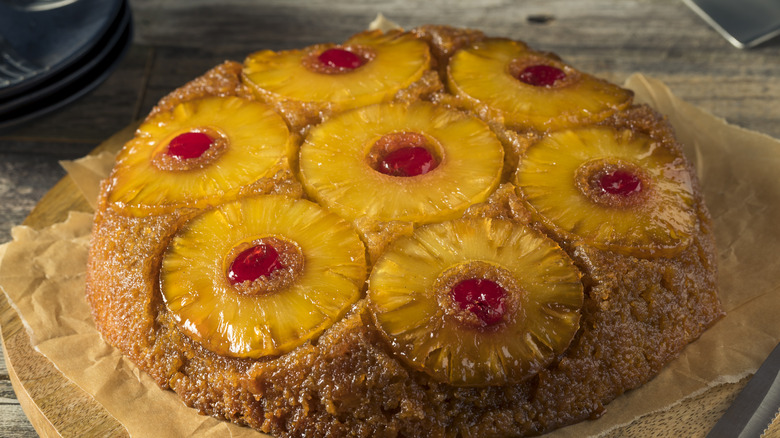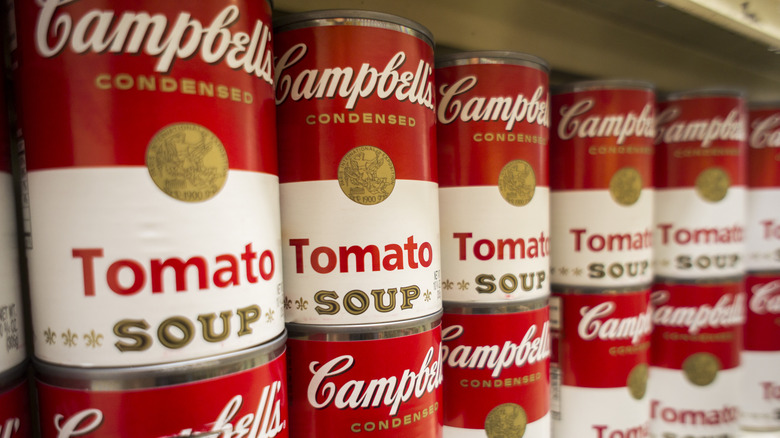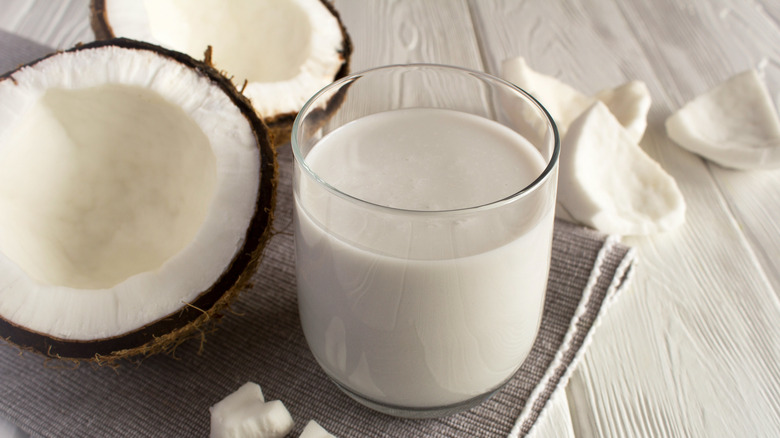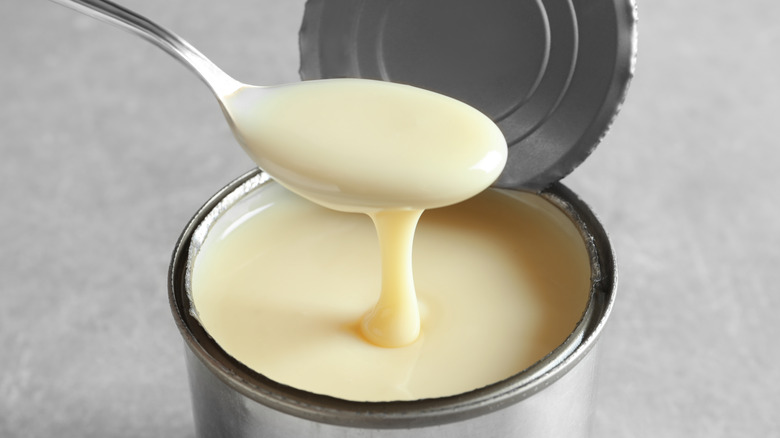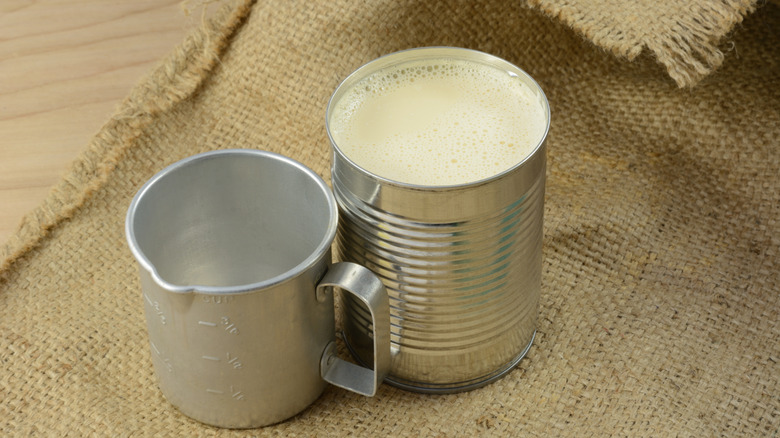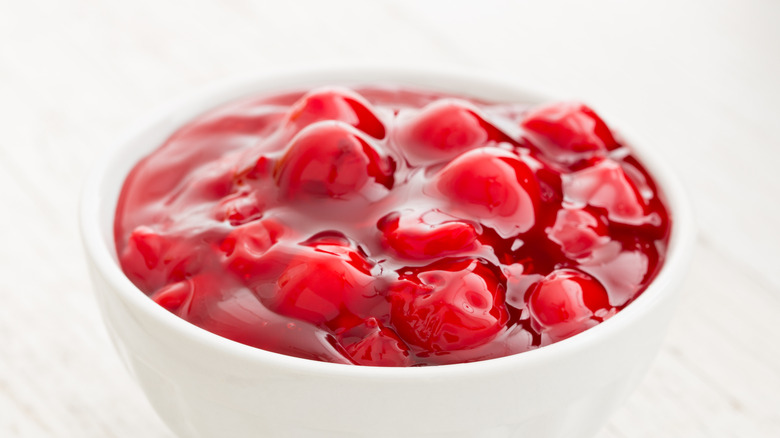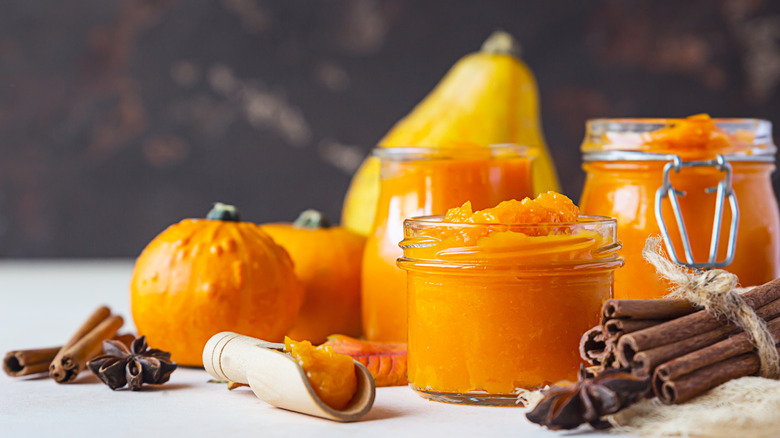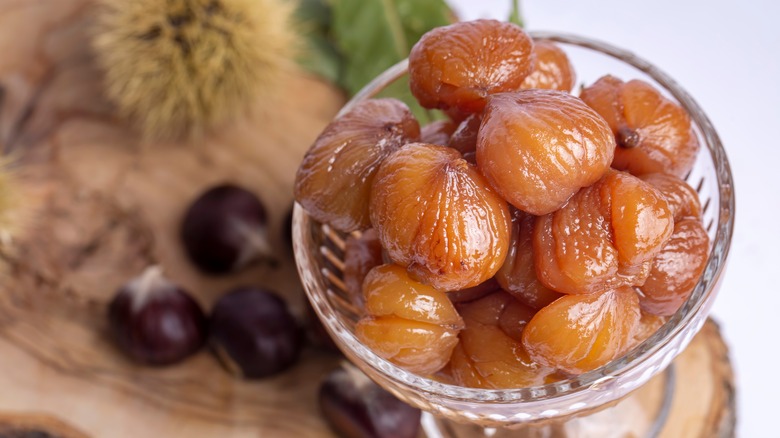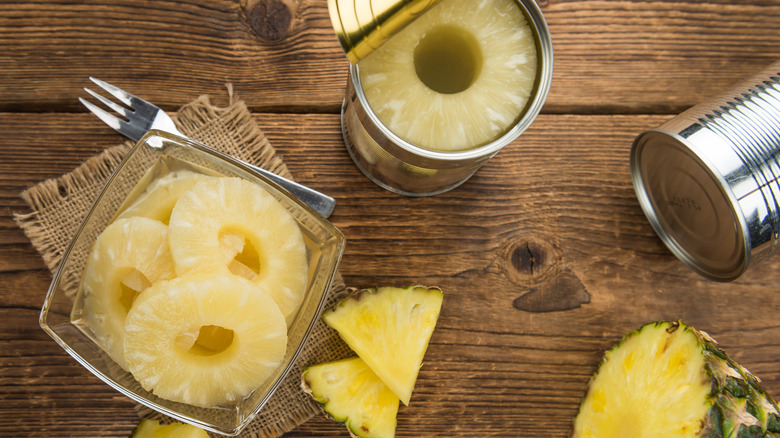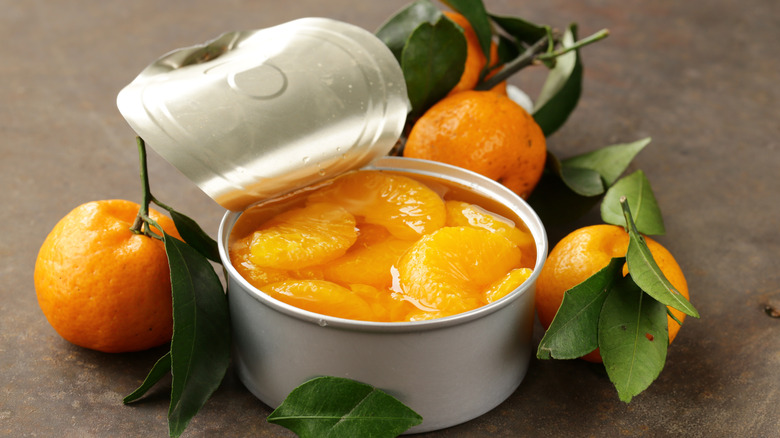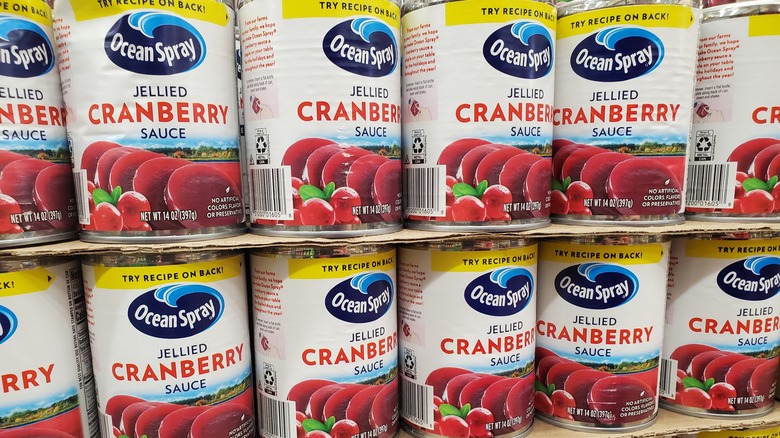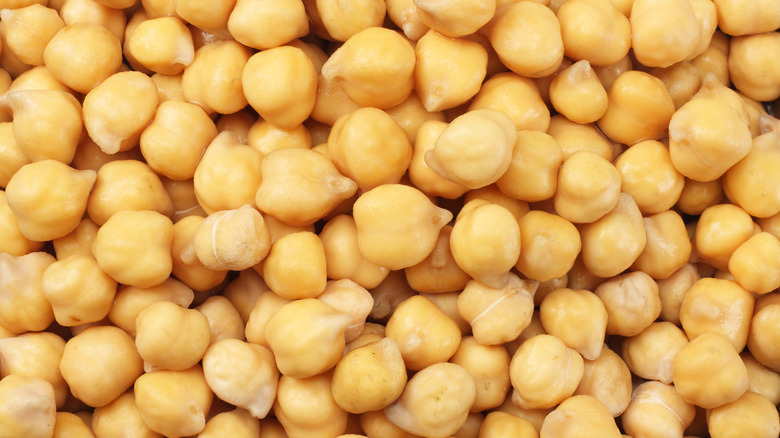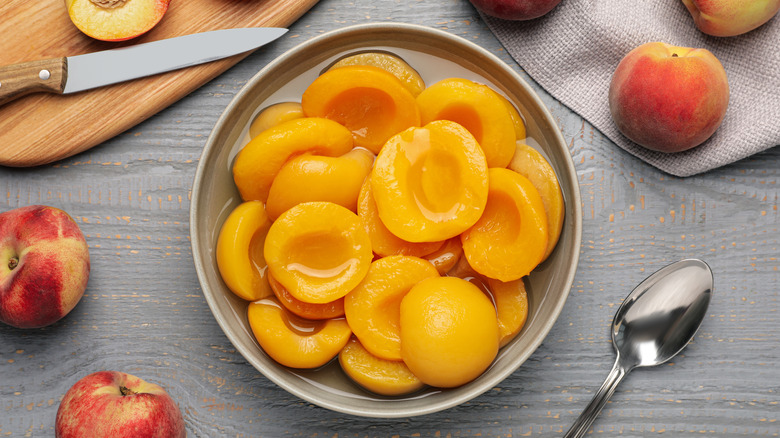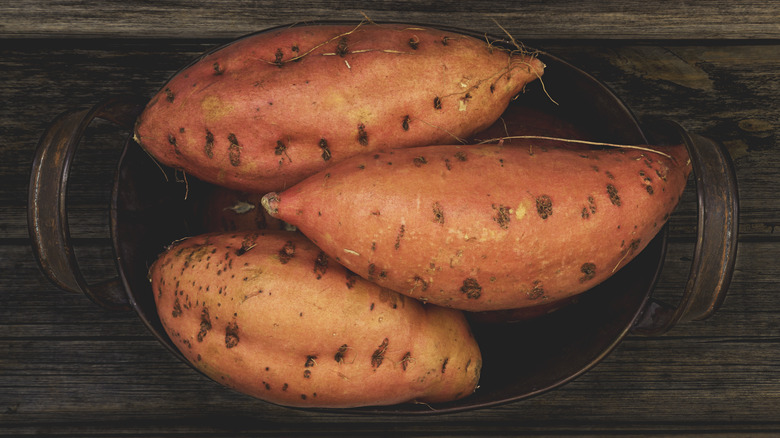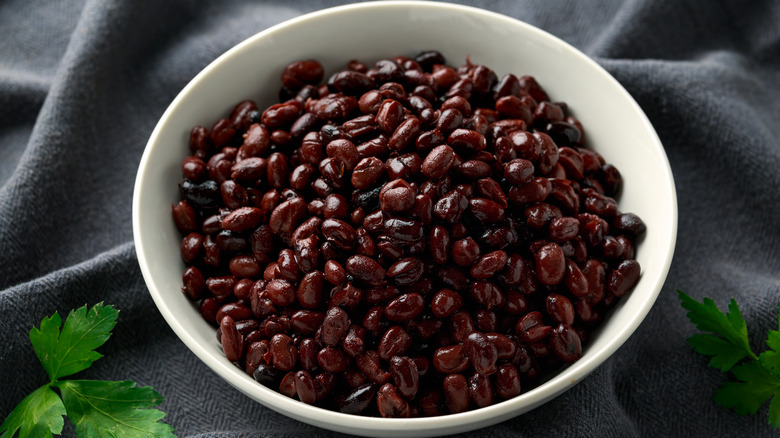Canned Ingredients That Will Seriously Upgrade Your Cake Recipes
You might associate home baking with meticulously measured flour, freshly whipped cream, and glistening fresh fruits. But in reality, it rarely looks like that. From frozen berries to cake mix, baking relies on a wide range of products that aren't freshly procured from the farmer's market. Poke your head into your pantry and you might find rows of untapped baking potential. Canned foods can serve as quick and easy upgrades that are delicious and unique. They also offer a consistency in flavor and texture that you can't always get from fresh ingredients, ensuring that your baked goods are reliably delicious every time.
Canned ingredients open up a host of cake-baking possibilities, all without the hassle of peeling, chopping, or puréeing. And while many of us think of fresh foods as being more nutritious, there is evidence to suggest otherwise. According to the Academy of Nutrition and Dietetics, canned foods are packaged at peak freshness, which also happens to be when they have the highest nutritional value. Additionally, a 2015 study from the University of California, Davis found that people who frequently consume canned foods have higher nutrient intakes than people who do not, likely because canned foods are an accessible, quick way to consume fruits and vegetables. So, the next time you decide to bake a cake, head to the pantry, and grab some cans. Here are a few options to get you started.
Tomato soup
Soup and cake are not a classic combination, but it's worth keeping an open mind because a can of tomato soup is one of the best-kept secrets to a moist cake. The idea supposedly dates back to the turn of the 20th century before rising agents such as baking powder and baking soda were readily available (per Atlas Obscura). Like buttermilk, tomato soup contains the acid necessary to form bubbles and make the cake rise. The first known recipe was printed in 1922 and later became popular when Depression-era bakers had to settle for cheap ingredients. Cans of tomato soup were easy to come by and affordable, making them the perfect addition.
The cake was popular throughout the first half of the 20th century and was even a favorite recipe of the poet Sylvia Plath, but has fallen out of favor in the ensuing decades. Tomato soup provides a combination of feather-lightness and moistness, coveted characteristics that are difficult to achieve in the same recipe. As long as you pick a plain soup — garlic and basil are not your friends here — the final product will not taste like tomatoes. Instead, the cake will be soft, moist, sweet, and just a little tangy.
Coconut milk
Despite its subtle sweetness, coconut milk is often found in savory recipes, such as creamy soups and curries. However, when added to desserts, this ingredient unlocks another dimension of rich flavor that can transform a plain recipe into something you'll want to make again and again. Whether you're using it in conjunction with coconut shavings or simply substituting it for dairy milk in a chocolate or vanilla cake, coconut milk will take your recipe in a whole new direction.
Made by extracting the liquid from the white meat of coconuts, coconut milk should not be confused with coconut water, which is the clear liquid found inside a coconut when you crack it open. The milk is full of fat and flavor. If you're substituting it for dairy milk, always stick to the full-fat version. Reduced fat versions will add liquid without providing the silky texture you're after, and the cake may turn out dense rather than rich. If the recipe calls for full-fat yogurt or cream, you can take things a step further by using only the creamiest part. Coconut milk tends to separate, leaving you with a thick, white layer at the top of the can and a thin, translucent layer underneath. Using the top layer will give you the creamiest dairy substitute.
Condensed milk
Condensed milk is one of those ingredients that you might have used a time or two when a recipe called for it, but aren't quite sure what it is. The sweet, gooey mixture is often used in recipes for flan, fudge, and Key lime pie, but can be used to enhance the texture and flavor of cake, too. It was invented in the 1800s as a way to preserve milk, a notoriously perishable product. Inventor Gail Borden created the syrupy liquid by boiling off most of the water in the milk, adding sugar to prevent the growth of bacteria, and sealing it in cans.
When it comes to baking, condensed milk provides a dense, sweet, milk-flavored substance that doesn't drown the other ingredients in liquid. It can be used in any recipe that calls for milk and sugar, but you'll need to adjust the recipe to avoid an inedibly sweet result. Adding condensed milk to the cake provides moisture and richness, making it perfect for heavy, decadent cakes rather than airy ones. Many bakers will know it as one of the three varieties of milk found in tres leches cake, but it's worth experimenting with other recipes, too. Try it in this strawberry cake, for example, or kickstart your holiday baking with this candy cane cake. Trust us, this simple substitution pays dividends.
Evaporated milk
Like condensed milk, evaporated milk is one of those mysterious ingredients that crops up in recipes from time to time, but which many of us would struggle to define. It is similar to condensed milk in that it involves milk and evaporation, but unlike condensed milk, it isn't sweet, meaning that you can use it in savory recipes, too. It's made by simmering away part of the water content in fresh milk, but because it does not have added sugar, it is thinner in consistency than condensed milk.
Evaporated milk can be used instead of cream in cake recipes, or instead of milk if you want a richer texture. It provides a creamy, lightly caramelized flavor due to the heating process it undergoes before being canned, and imparts a subtle beige or warm tan color compared to the pure white of milk. Because it doesn't have added sugar, you can easily swap it into a recipe instead of milk, though if you don't want a rich, dense texture, you should add a few teaspoons of water.
Cherry pie filling
Cherries are an expensive and labor-intensive baking ingredient. If you buy them fresh, you'll spend a fair bit of money and be required to remove the pits by hand. If you buy them frozen, they can still be on the expensive side, and tend to bleed into the batter, turning it pink. Cherry pie filling offers a solution. For one thing, it's extremely affordable compared to fresh cherries. As of this writing, a 21-ounce can of cherry pie filling from Randalls costs only $3.49 compared to $4.99 for 16 ounces of fresh cherries. Considering you'll need more fresh cherries than canned due to the weight of the pits, there's an even bigger price difference.
Aside from being cost-effective, cherry pie filling does not bleed into the batter the way frozen cherries do if you're using it to make a decorative swirl. You will need to adjust the sugar in your recipe to accommodate for the added sweetness in the filling, but aside from that minor inconvenience, it is an easy addition that adds color and a deliciously sharp flavor to an otherwise plain cake.
Pumpkin
Whether it's spooky season or the middle of summer, pumpkin is a winning ingredient. You can put it in everything from soup to lattes, but we're partial to its effect in baking. When put into cake, canned pumpkin provides a luscious, moist texture and a hint of sweetness. It also gives cakes a rich orange color that heightens the overall appeal, and contrasts beautifully with cream cheese frosting or a light buttercream.
Pumpkin is synonymous with fall, and when adding it to cake, you may as well go all the way and include a healthy dose of cinnamon, nutmeg, cloves, and ginger. Not only will it fill your kitchen with an intoxicating aroma of all things cozy and autumnal, but it will provide a finished product that is spicy and warming. You can use plain pumpkin purée and add spices, or opt for a can of pumpkin pie filling. If you choose the latter, make sure to cut back on the prescribed amount of sugar in the recipe. Whether you're making a pumpkin coffee cake or keeping things simple with this 3-ingredient marshmallow pumpkin cake, canned pumpkin is a unique ingredient that imbues almost any recipe with a sense of coziness and comfort.
Chestnuts
Chestnuts are nutritious and are unique in their high moisture content. Unless you have access to fresh chestnuts and plan to use them within a week or two, you will need to buy them preserved. Canned chestnuts have been peeled, cooked, and preserved in water or syrup, and you can buy them whole, chopped, or puréed. They have a mildly sweet, nutty flavor and meaty texture that makes them delicious in both sweet and savory dishes.
When adding them to the cake, you have multiple options. If you're using chopped chestnuts, you can simply toss them into the batter as you would any other type of nut. However, many recipes call for purée, which can be mixed with sugar and butter to make a creamy, nutty icing, or folded into the batter. Chestnuts are often paired with chocolate, but you can add them to any kind of cake to introduce a sweet, buttery flavor.
Pineapple
Canned pineapple has a long history of being included in desserts, so much so that some might dismiss it as a retro ingredient. From Watergate salad to puddings and trifles, it conjures images of lace curtains and shag carpets. But don't discount this sweet, tangy fruit. When added to cakes, it provides flavors and textures that you can't get from other options, and is much easier to prepare than a spiky whole pineapple.
Cakes that feature canned pineapple include hummingbird cake and some recipes for carrot cake, but there's no reason not to expand into wider territory. Whether you're making a vanilla pound cake or coconut cream cake, pineapple will provide a tropical spin. Aside from its sweet, tangy flavor, the fruit offers moisture and a fibrous texture. However, like fresh pineapple, which can be as tough and stringy as celery, canned pineapple is much softer and does not necessitate the use of dental floss.
Mandarin oranges
You might associate mandarin oranges with elementary school lunches, but these little wedges of sugary citrus are just as well-suited to home baking as they are to cafeteria trays and lunch boxes. With their light, summery flavor, they put a fresh spin on anything you choose to put them in.
The main things to consider when adding mandarin oranges to cake are their sugar content and their added liquid. A half cup of Del Monte Mandarin Oranges in light syrup contains 15 grams of sugar, which equates to nearly 4 teaspoons. Unless you have an insatiable sweet tooth, you'll need to pare back the sugar in the recipe to accommodate. Additionally, mandarin oranges are 85% water which, when combined with the syrup they're usually canned in, will impact the texture of your cake. Draining the oranges will mitigate the moisture, as will cutting back on the liquid in your recipe. Alternatively, you can simply replace the liquid in the recipe with the syrup from the can, as is usually the case in recipes for the classic Southern pig pickin' cake. With all these caveats in mind, you can start adding mandarin oranges to all your favorite cake flavors.
Cranberry sauce
Many Black Friday shoppers are on the hunt for big deals on furniture and electronics, but if you happen to see a shelf of deeply discounted cans of cranberry sauce, grab them. This ubiquitous Thanksgiving dish that always seems to languish in the fridge for weeks afterward is a surprisingly delicious addition to cakes at any time of the year. Cranberries are tart and juicy, and with the addition of plenty of sugar, are sweet like candy.
There are many ways to incorporate cranberry sauce into a cake. One option is to add it directly into the batter, introducing a pink hue. Another is to pour half the batter into the cake tin, spread the cranberry sauce on top, and then cover it with the second half to create a red streak through the middle. You can also add it on top of the batter, giving the surface of the cake a red marble finish. Another option is to blend the cranberry sauce into a frosting or glaze, lending a vibrant, rosy tint and tangy flavor to the topping that complements the cake underneath. This canned ingredient can be used to dress up a plain vanilla or coffee cake, along with just about any other recipe you can dream up.
Chickpeas
Without realizing it, you may have already eaten a cake made with chickpeas. They can be used as a starchy, neutral-flavored substitute for flour, but they are also the gold standard when it comes to vegan substitutes for eggs. The liquid found in a can of chickpeas, known as aquafaba, can be whipped into stiff white peaks just like egg whites. This is because chickpeas and other legumes contain albumins and globulins, the same proteins that cause egg whites to stiffen. Chefs favor chickpea water because it tends to have a higher concentration of these proteins than other legumes, and it conveniently carries little flavor.
You can use aquafaba as you would eggs in a cake recipe. If the instructions call for stiff, white peaks of egg whites, you can whip the viscous liquid by itself before folding it into the batter. If they call for whole eggs, simply mix the liquid with the wet ingredients as specified without beating it first. It might sound like an unlikely substitute, but you probably won't notice a difference between a cake made with eggs and one made with aquafaba.
Peaches
Sadly, peach season is finite, and in recent years, weather has ruined peach crops across the country. In 2023, for example, approximately 90% of Georgia's crop was wiped out due to inclement weather and the warming climate (per W.A.B.E.). During rough years like this, peaches can be very expensive, and their quality can vary greatly. For these reasons, canned peaches are a welcome alternative. Peeled, sliced, and pitted, they are convenient, reliable, and cost-effective.
Peaches are also highly versatile. Their juicy sweetness is balanced by a slight tanginess, while their thick, almost creamy texture is perfect for baking. After some time in the oven, they are so soft they almost melt in your mouth. There are many ways to incorporate canned peaches into cake, but they are so delicious that you may as well choose the easiest option: drain them and layer them on top of the batter. You can also line them on the bottom of the pan for an elegant upside-down cake, or sandwich them in between cake layers. Whether you're making chocolate, vanilla, or spice cake, canned peaches will make a great recipe even better.
Sweet potatoes or yams
Despite their many similarities to pumpkin, sweet potatoes are often left out of cake recipes. In taste, appearance, and texture, they are almost interchangeable with the autumnal gourd, but there are meaningful differences. Sweet potatoes are a root, for one thing, while pumpkins are a gourd. They are also sweeter and starchier than pumpkins, making them slightly creamier when baked. Using canned sweet potatoes (which are often labeled as yams in the U.S. despite being very different from the savory yams you'd find in West Africa and the Caribbean) saves you from having to roast them yourself. Like pumpkin, sweet potatoes take a long time to cook, and when you're already setting aside an hour or two to make a cake, you don't want to tack on another 30 minutes to an hour just to cook the potatoes.
Adding sweet potatoes to cake is easy. Simply pour them into the batter with the rest of the wet ingredients. They will turn the cake into a pleasing shade of orange, and impart a natural earthy sweetness that is surprisingly distinct from pumpkin. Their flavor is so irresistible that you don't need to add as many spices as you would in a pumpkin spice cake. Letting the sweet potatoes speak for themselves will yield delicious and unique results.
Black beans
Before you shudder at the very thought of this ingredient combination, allow us to make a case for putting black beans in cake. We're not suggesting you dump a can into your next angel food cake or sprinkle a cup of them over a red velvet cake. Instead, we suggest you blend them into a paste, and use them as a nutritious and yes, tasty, alternative to flour. When liberated from their associations with tacos and soups, black beans are remarkably mild in flavor, and their high starch content makes them creamy when blended.
Black beans are most commonly found in chocolate cakes. Their flavor is hidden behind the distinctive taste of chocolate and their dark color deepens the color of cocoa powder. When making a cake with black beans, make sure you're using a can that has no salt to avoid a cake that tastes like a horrible mashup between dinner and dessert. Whip up your favorite chocolate buttercream frosting, and prepare to be amazed at how delicious the final product is. Even if you aren't gluten-free or particularly health-conscious, black bean chocolate cake will win you over.
